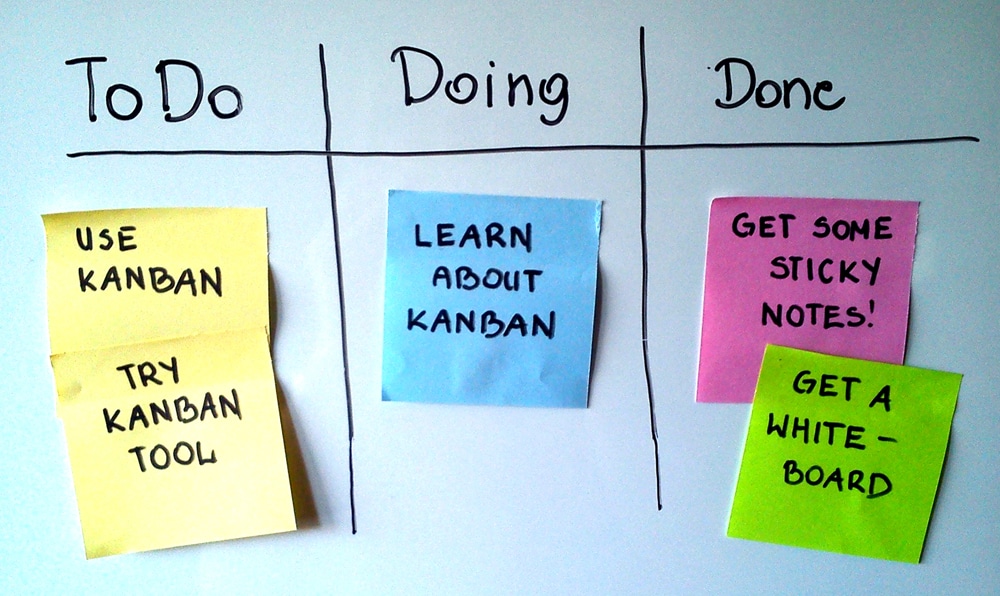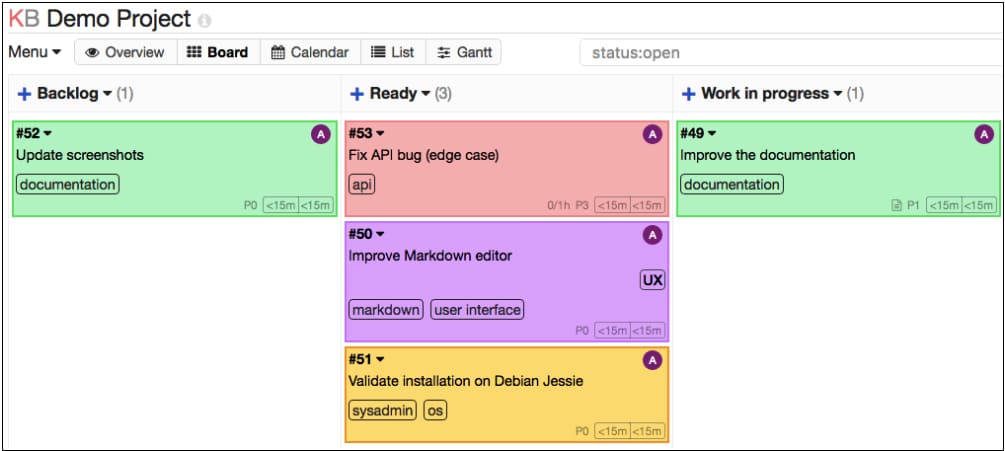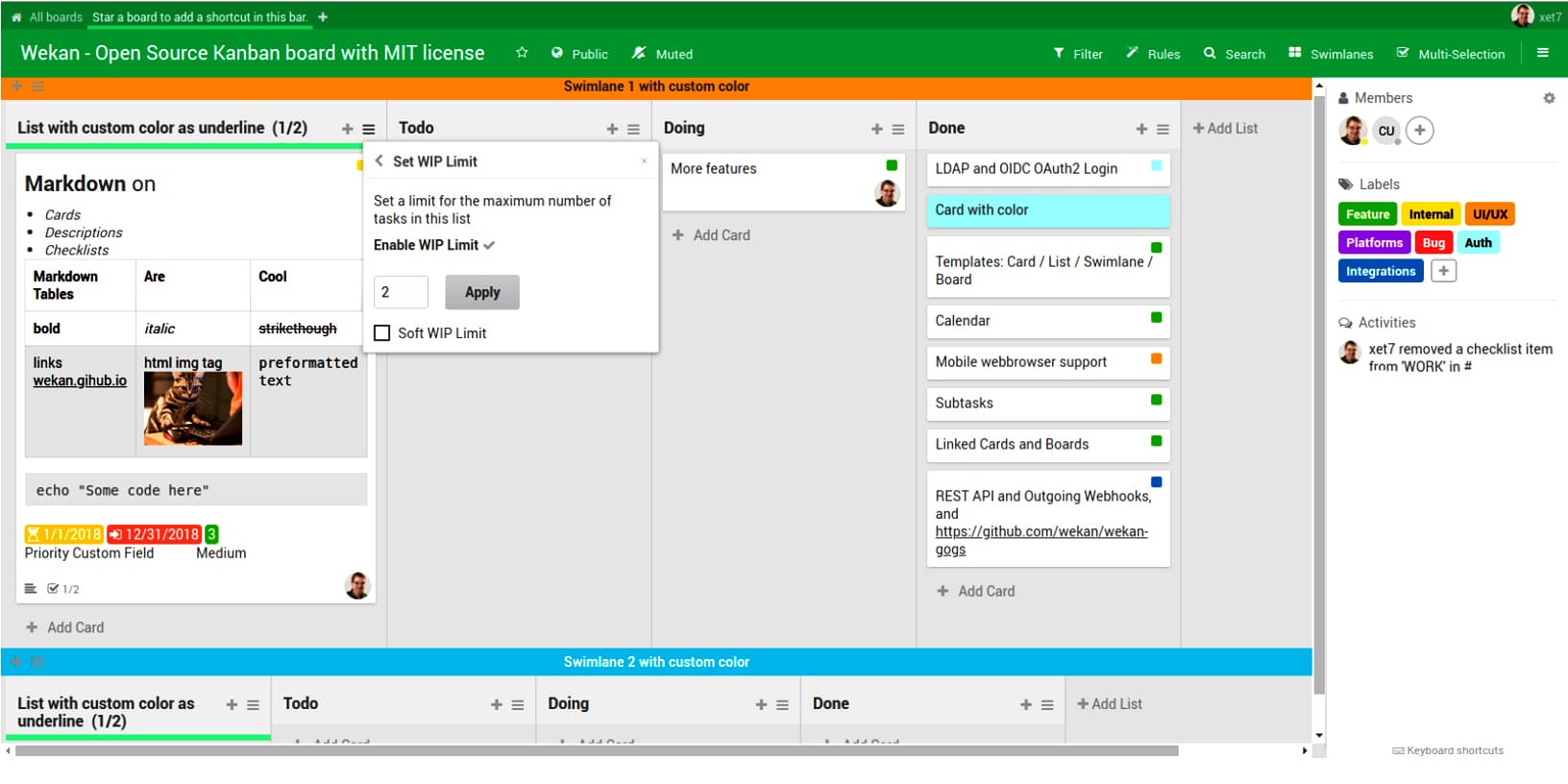In the first part of this series of articles on open source project management tools, we looked at desktop tools like MS Project. Part 2 discussed project servers like MS Project Server. In Part 3 we looked at agile/Scrum software project management tools. In this fourth and final part, we will see how Kanban helps in managing projects.
Management of an event — a VIP visit to your factory, relocation of your office or an open house — requires the assignment of tasks to different people, keeping an eye on work in progress and making sure nothing slips through the cracks. These projects do not warrant going through a full-fledged project management routine. A simple tool like Kanban that is easy to set up, and easy to access and work with for everyone in the team is the need of the day.
If the entire team works in one location, these projects can be run using sticky notes moved across a series of status columns on a whiteboard. Everyone can see at a glance who is working on what, if any essential tasks are missing, and whether the team is making good progress towards meeting the deadlines.
Team members can choose tasks from the ‘To Do’ column and add their names to the sticky note. Or the team leader or coordinator can assign tasks to them. When the persons responsible start the tasks, they move the sticky note into the ‘Doing’ column. When they are done, the note is put in the ‘Done’ column and a new task is chosen by the team members. If the process requires other status columns such as ‘In Verification’ or ‘Blocked’, they can be added, as needed.
But if some of the team members are working in different locations or from home, or there are outside vendors or contractors involved, it is not possible to use this physical board. Kanban board software tools are designed to manage such lightweight projects worked on by a distributed team. These tools are ideal for monitoring the progress of work through different stages, which can be viewed as a workflow.

Features of Kanban
Kanban originated in the automotive industry in Japan. Toyota developed a production system called just-in-time manufacturing (JIT) to improve manufacturing efficiency which used a Kanban board. Kanban in manufacturing is pull based, namely, driven by demand from downstream processes. Giving visibility to who owns each task, where each task is in the process stages, as well as keeping a tight check on work in progress (WIP) are all in-line with the Kanban used in manufacturing.
Visual and clear overview of tasks
The Kanban board is the best way to know the current status of a project at a glance because it is visual. It’s very easy to understand, there is nothing to explain and no training is required. Everyone can see who is doing what, the status of a task and whether any tasks are blocked.
Work in progress (WIP) can be capped
When teams juggle between multiple tasks, they lose focus and get distracted. Maybe your team is great at starting tasks but not so good at finishing them. You end up with many things partially done, very few completed and an increasingly confusing backlog of items that need to be addressed. Team members often waste some time and energy to pick up the thread where they left off and get back to the task after being distracted. The WIP limits prevent this wasted effort and energy by keeping new tasks out of the workflow until previous tasks have been fully completed.

Swimlanes for different work types
All work need not be brought into the same pool. You can have separate swimlanes for different types of work. For example, if you have some normal tasks and some priority tasks, you don’t want the priority tasks to get buried under a lot of normal tasks. In such a situation, you can set up separate swimlanes for each type of task. Kanban swimlanes are horizontal bands that split a Kanban board into sections. You can also use them to visually separate, say, two sub-projects, within the larger project, on the same board and organise related tasks together.
Sub-tasks to show progress within a task
In the case of large tasks, it is not enough to know that the task is in progress. If you find out that a task is way behind schedule too close to the deadline, there may not be enough time to rectify that through emergency corrective actions. In proper project management tools that use a Gantt chart, this is handled by updating the task status with a percentage completion for each task. Kanban boards use a checklist of sub-tasks as a way of splitting a larger task into smaller chunks. The team member can keep crossing out completed items on the checklist, which gives a rough measure of how the task is progressing.
Adding comments and attaching documents to tasks
Team members may want to pass on information related to a task to the person doing that job. This will help the person who may have to test it later or help the supervisor too. The usual method of sending that information or attachment is by email, which is often difficult to trace. Instead of burying it in email, if the information is added as a comment or as an attachment to the task, it gives visibility to all concerned in a context-sensitive manner.

Connecting to your LDAP server for authentication
LDAP is the industry standard protocol for accessing and maintaining directory information of, say, all the employees of an organisation. Microsoft’s Active Directory and OpenLDAP, for example, are LDAP-compliant directory services. When you log into your company’s network, your user name and password are likely validated through this. If all team members are employees of your organisation, won’t it be convenient if you can tap into your organisation’s authentication system? The Kanban boards support connecting to your organisation’s LDAP server for authentication.
A lightweight and simple user interface
Kanboard developers follow an approach of voluntarily limiting the number of features so that its operation is simple and users do not get overwhelmed. There is no fancy user interface, and the focus is on simplicity and minimalism. The developers claim: “It’s very easy to understand, there is nothing to explain and no training is required.” To make it easier for users, Kanboard supports automated actions for repetitive tasks based on events.
Wekan: Feature-rich and more Trello-like
Trello is the most popular among the commercial Kanban tools. Among the open source Kanban tools, Wekan closely resembles Trello. Wekan also has the capability to import a board from Trello. In early 2020, Wekan conducted a survey of the organisations that use its software, and 155 organisations across Europe, America and Asia responded. Their user base ranged from 1 to 800. So it appears that Wekan can scale to very large teams.
Wekan progressive Web app (PWA) in Android and Apple phones
Wekan has support for PWA. Even though this is a Web application, when viewed through a browser, it feels like an app to the user with app-style interactions and navigation. It also uses a full screen, unlike a browser. In addition, just like any application, it provides home screen icons as well.
Kanban boards are suitable not only for projects but also for ongoing tasks. Let us say that you have a team to attend to customer support tickets. This is not a project. It has no defined overall target that needs to be accomplished in a defined time frame. Tickets keep coming in and they need to be attended to on an ongoing basis. Kanban boards are well suited for this kind of work as well.
Project metrics in Kanban boards
Typically, people monitor throughput, cycle time and work item aging. Cumulative flow diagram (CFD) plots the number of cards at each stage of the Kanban workflow on a daily or even hourly basis. Increasing thickness of any individual band indicates a bottleneck in that stage of the workflow. This may be because of delays in that step or because of a hold up in the next step in the process.
Other open source tools in this space and why they are not recommended
RestyaBoard
The community edition is limited to a maximum of 10 users. It has ‘Task’ and ‘To Do’ management workflow only, and no Kanban workflow.
TaskBoard
A mailing list or a discussion forum is a ‘must have’ for any open source software. We can see how other people are using it and what issues they are running into. We can also post a question and get help from other users, if not the developers. Unfortunately, TaskBoard neither has a mailing list nor a discussion forum.
Taiga and Tuleap
Taiga and Tuleap, and also some of the other Scrum project tools, have back-fitted Kanban capability into their existing tool. If you are already operating one of these, the balance of convenience may dictate that you try their Kanban features. However, if you are starting afresh, we recommend using one of the Kanban software tools.
Project team members get frustrated if leaders impose a heavy process that involves filling out many forms and filing innumerable reports. At the same time, it is impossible to achieve good coordination and communication by seat-of-the-pants management. Kanban is a lightweight tool that is simple to use and highly effective in project management.








































































